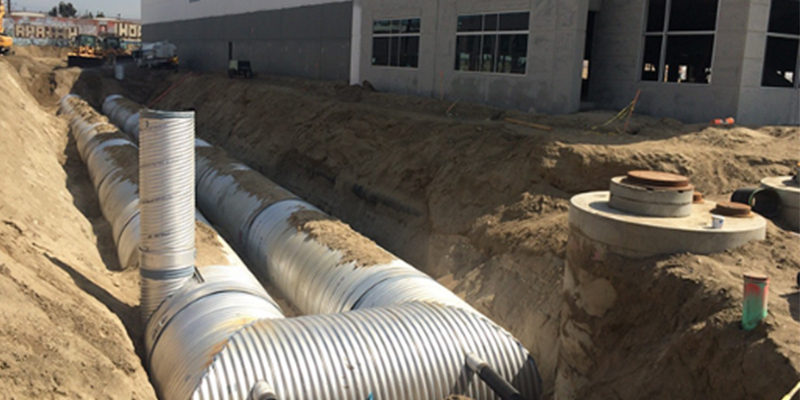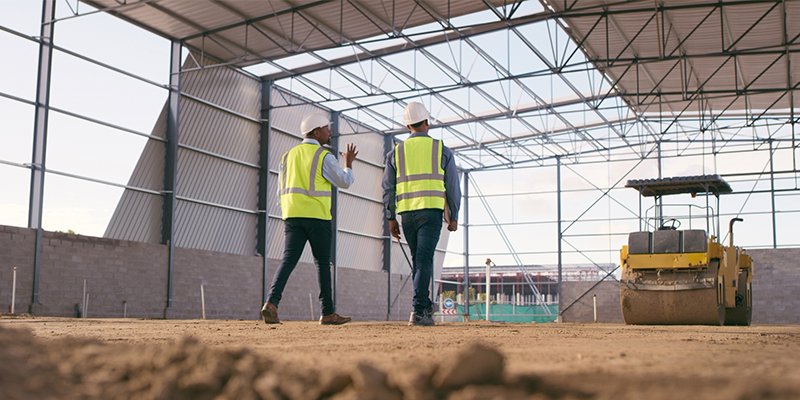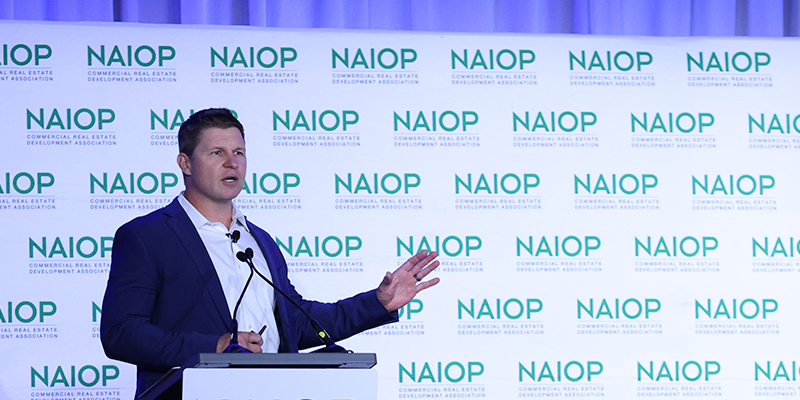Stormwater management considerations are a vital part of the site selection and development process – and can impact the long-term value of a property. In fact, the majority of land development projects over one acre require a stormwater management system so it’s important to understand the available options as well as their pros and cons.
Stormwater management is traditionally executed on the surface with a pond that controls how much water can be released typically at or below historic flow rates. One alternative is to create an underground detention system. It is most often used in developments where land availability, parcel limitations and land costs do not allow the development of surface stormwater Best Management Practices (BMPs).
It’s important to consider when and why it is appropriate to implement underground vs. above-ground solutions to maximize the long-term real estate value of properties.
Why Go Underground?
The main reason to consider underground detention is the return on investment on the value of the increased land or building capture. There are increased capital costs initially compared to a surface solution, but underground detention provides more outdoor storage and the opportunity for increased building sizes and larger parking lots.
Underground is a good option for high density, urban areas with limited available space, unusually shaped parcels, or in markets where land is more expensive.
Benefits
In addition to the land capture costs, benefits can also include increased public safety compared to ponds and other surface stormwater BMPs, and insulation from freezing.
Lastly, the most obvious benefit to an underground system is the aesthetic, especially on dense sites. Often, surface BMPs are located in tight areas that do not provide for enough relief to make these surface installations look like a natural, aesthetically pleasing element to the project.
Crucial Considerations
Important considerations when implementing an underground detention system include:
- Long-term maintenance – including accessibility and creating a strong operations plan.
- Placement of the underground storage system – this is specific to the site and how it is interacting with the landscape areas, drive lanes, parking, existing and proposed utilities, and downstream storm sewer.
- Alternative water quality treatment requirements – this may be necessary with an underground solution to account for water quality components of the site, often not included in underground structures.
- Jurisdictional support – this is very important at the start of a project. Some underground system suppliers benefit from having pre-approved systems within their respective jurisdiction.
And last but certainly not least, it is critical to work with an experienced land development civil engineering team that understands the jurisdictional allowances along with a great relationship with the suppliers and installers of the actual system that will be implemented. The experience factor of the team helps accurately define the cost early and influences the decision whether to go underground and move forward on the project.
There are various design options to evaluate to obtain a successful stormwater solution that achieves the site’s development goals.
Solutions and Examples
In addition to the typical underground detention solution, where the stormwater management is fully underground, there are other options depending on the site requirements and local jurisdictions including:
- Hybrid – combining underground and surface solutions.
- Rooftop solution – rooftop detention provides many positive solutions to the site space provided and project cost when there are limited site options to design a pond. Jurisdictional codes typically dictate the allowance for this type of solution.
- Stormwater vault – a unique solution that incorporates a vault into an underground parking garage or foundation structure in multifamily, office and retail infill projects.
There are various considerations of underground detention solutions across the country and on an international level. Regional impacts are very important to the solution selected and define the adoption of the program. Three unique solutions our teams have implemented include:
TruStile
This manufacturing plant project had very concrete space requirements for proper operation and was located on a relatively small site. A traditionally lined pond was too large to fit within the proposed site layout and an underground solution was designed for the site that was located under the proposed parking lot. Coordination with the local jurisdiction for allowance and approval of the system was completed for this solution, the first of its kind in Colorado. The underground system gained the necessary space for our client’s required building size and orientation goals, leading to a successful project outcome.
South San Francisco Industrial Site
Our client was repurposing an old GSA building and site that had chronic drainage issues that required the installation of a detention pond. An adjacent parcel of land was acquired to allow for jurisdictional requirements of a larger property line setback, additional emergency access and stormwater detention. With the emergency access requirement, there was not enough space for a detention pond. Our solution to provide the required detention included twin 60-inch pipes that were 1,200 feet long designed under the access road. This installation allowed for the site and building to meet code, providing for a successful building repurpose.
York Street Apartments
The client for the York Street Apartments maximized site coverage for the residential building on this 2-acre site. A rooftop detention solution was not desirable due to the layout of the building and rooftop configuration. An underground detention and sand filter vault was incorporated into the structural design of the parking ramp with manhole access from the ramp.
Team Approach
Collaboration between owner, architect, engineer and general contractor is crucial to incorporate innovative measures of stormwater to achieve more usable site.
Stormwater management is a critical and necessary part of the development process. Different options should be considered to determine whether underground or surface detention is the best solution for the site to maximize the long-term real estate of properties.
Featured photo courtesy of Ware Malcomb.







